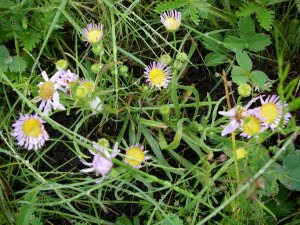
Outplanting Willamette Daisy
 |
| Willamette daisy in flower photo: Burl Martin 2008 |
Common Name: Willamette daisy or Willamette fleabane
Scientific Name: Erigeron decumbens
Species Listing Staus: Erigeron decumbens is listed by the U.S. Fish and Wildlife Service (USFWS) and Oregon Department of Agriculture (ODA) as an endangered species. It is also considered a Special Status Species by the Bureau of Land Managment (BLM).
Distribution: This endemic species is native to prairies in Oregon’s Willamette Valley. Today, the number of extant populations is numbered at about 40. Approximately half of these populations are protected on public lands.
 |
| Willamette daisy seedlings waiting to be planted |
Identification Tips: The Willamette daisy is a rosette forming perennial forb. It can be distinguished from similar species by the three prominent parallel veins which run the length of the leaf.
Interesting Facts: The name, decumbens, was originally designated by the famous botanist explorer, Thomas Nuttall, because the comparatively large flowers’ weight pulls its stem toward the ground, making them “decumbent”.
Project Description: We outplanted over 1500 Willamette daisy at the William Finley National Wildlife Reserve and Fern Ridge Reservoir in West Eugene. The objectives of this project are,
1. To evaluate different treatments, such as burning, grazing, mowing, and grass herbicide effects on Willamette daisy populations, and
2. Enhance our understanding of Willamette daisy population demography.
The Willamette daisy is in decline due to habitat loss and fragmentation. One of the effects of this has been low seed viability due to inbreeding depression in small populations. For more information, see the Willamette daisy reports at appliedeco.org.
Project Partners:
U.S. Fish and Wildlife Service, including Finley National Wildlife Refuge
U.S. Army Corps of Engineers, Fernridge Natural Area
U.S.D.A. Natural Resources Conservation Services, Plant Materials Center
 |
| Alex, Autumn, and Geoff Gardner |
